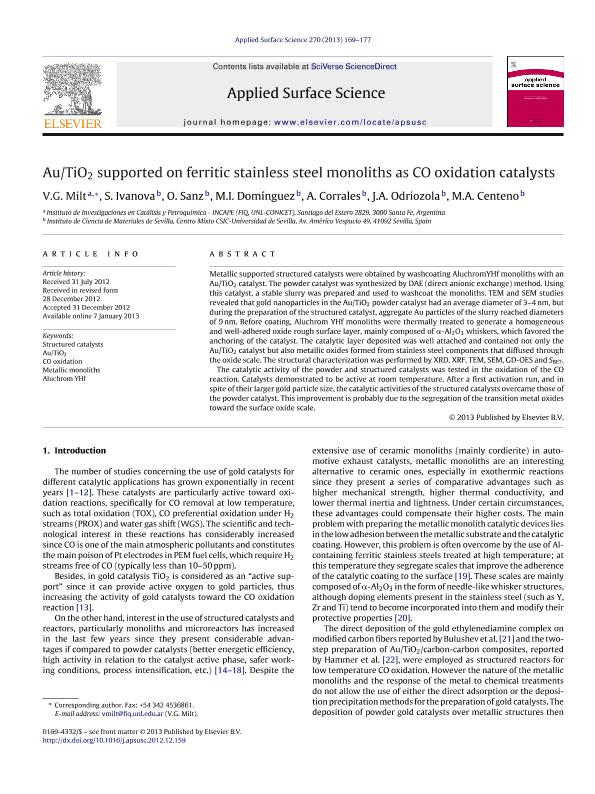Mostrar el registro sencillo del ítem
dc.contributor.author
Milt, Viviana Guadalupe

dc.contributor.author
Ivanova, S.
dc.contributor.author
Sanz, O.
dc.contributor.author
Domínguez, M. I.
dc.contributor.author
Corrales, A.
dc.contributor.author
Odriozola, J.A.
dc.contributor.author
Centeno, M.A.
dc.date.available
2017-07-24T20:21:48Z
dc.date.issued
2013-01
dc.identifier.citation
Milt, Viviana Guadalupe; Ivanova, S.; Sanz, O.; Domínguez, M. I.; Corrales, A.; et al.; Au/TiO2 supported on ferritic stainless steel monoliths as CO oxidation catalysts; Elsevier; Applied Surface Science; 270; 1-2013; 169-177
dc.identifier.issn
0169-4332
dc.identifier.uri
http://hdl.handle.net/11336/21225
dc.description.abstract
Metallic supported structured catalysts were obtained by washcoating AluchromYHf monoliths with an Au/TiO2 catalyst. The powder catalyst was synthesized by DAE (direct anionic exchange) method. Using this catalyst, a stable slurry was prepared and used to washcoat the monoliths. TEM and SEM studies revealed that gold nanoparticles in the Au/TiO2 powder catalyst had an average diameter of 3–4 nm, but during the preparation of the structured catalyst, aggregate Au particles of the slurry reached diameters of 9 nm. Before coating, Aluchrom YHf monoliths were thermally treated to generate a homogeneous and well-adhered oxide rough surface layer, mainly composed of -Al2O3 whiskers, which favored the anchoring of the catalyst. The catalytic layer deposited was well attached and contained not only the Au/TiO2 catalyst but also metallic oxides formed from stainless steel components that diffused through the oxide scale. The structural characterization was performed by XRD, XRF, TEM, SEM, GD-OES and SBET.<br />The catalytic activity of the powder and structured catalysts was tested in the oxidation of the CO<br />reaction. Catalysts demonstrated to be active at room temperature. After a first activation run, and in spite of their larger gold particle size, the catalytic activities of the structured catalysts overcame those of the powder catalyst. This improvement is probably due to the segregation of the transition metal oxides toward the surface oxide scale.
dc.format
application/pdf
dc.language.iso
eng
dc.publisher
Elsevier

dc.rights
info:eu-repo/semantics/openAccess
dc.rights.uri
https://creativecommons.org/licenses/by-nc-sa/2.5/ar/
dc.subject
Structured Catalysts
dc.subject
Au/Tio2
dc.subject
Co Oxidation
dc.subject
Metallic Catalysts
dc.subject
Aluchrom Yhf
dc.subject.classification
Recubrimientos y Películas

dc.subject.classification
Ingeniería de los Materiales

dc.subject.classification
INGENIERÍAS Y TECNOLOGÍAS

dc.title
Au/TiO2 supported on ferritic stainless steel monoliths as CO oxidation catalysts
dc.type
info:eu-repo/semantics/article
dc.type
info:ar-repo/semantics/artículo
dc.type
info:eu-repo/semantics/publishedVersion
dc.date.updated
2017-07-19T20:35:15Z
dc.journal.volume
270
dc.journal.pagination
169-177
dc.journal.pais
Países Bajos

dc.journal.ciudad
Amsterdam
dc.description.fil
Fil: Milt, Viviana Guadalupe. Consejo Nacional de Investigaciones Científicas y Técnicas. Centro Científico Tecnológico Conicet - Santa Fe. Instituto de Investigaciones En Catalisis y Petroquímica "ing. Jose Miguel Parera". Universidad Nacional del Litoral. Instituto de Investigaciones En Catalisis y Petroquímica "ing. Jose Miguel Parera"; Argentina
dc.description.fil
Fil: Ivanova, S.. Universidad de Sevilla; España
dc.description.fil
Fil: Sanz, O.. Universidad de Sevilla; España
dc.description.fil
Fil: Domínguez, M. I.. Universidad de Sevilla; España
dc.description.fil
Fil: Corrales, A.. Universidad de Sevilla; España
dc.description.fil
Fil: Odriozola, J.A.. Universidad de Sevilla; España
dc.description.fil
Fil: Centeno, M.A.. Universidad de Sevilla; España
dc.journal.title
Applied Surface Science

dc.relation.alternativeid
info:eu-repo/semantics/altIdentifier/doi/http://dx.doi.org/10.1016/j.apsusc.2012.12.159
dc.relation.alternativeid
info:eu-repo/semantics/altIdentifier/url/http://www.sciencedirect.com/science/article/pii/S016943321300007X
Archivos asociados
